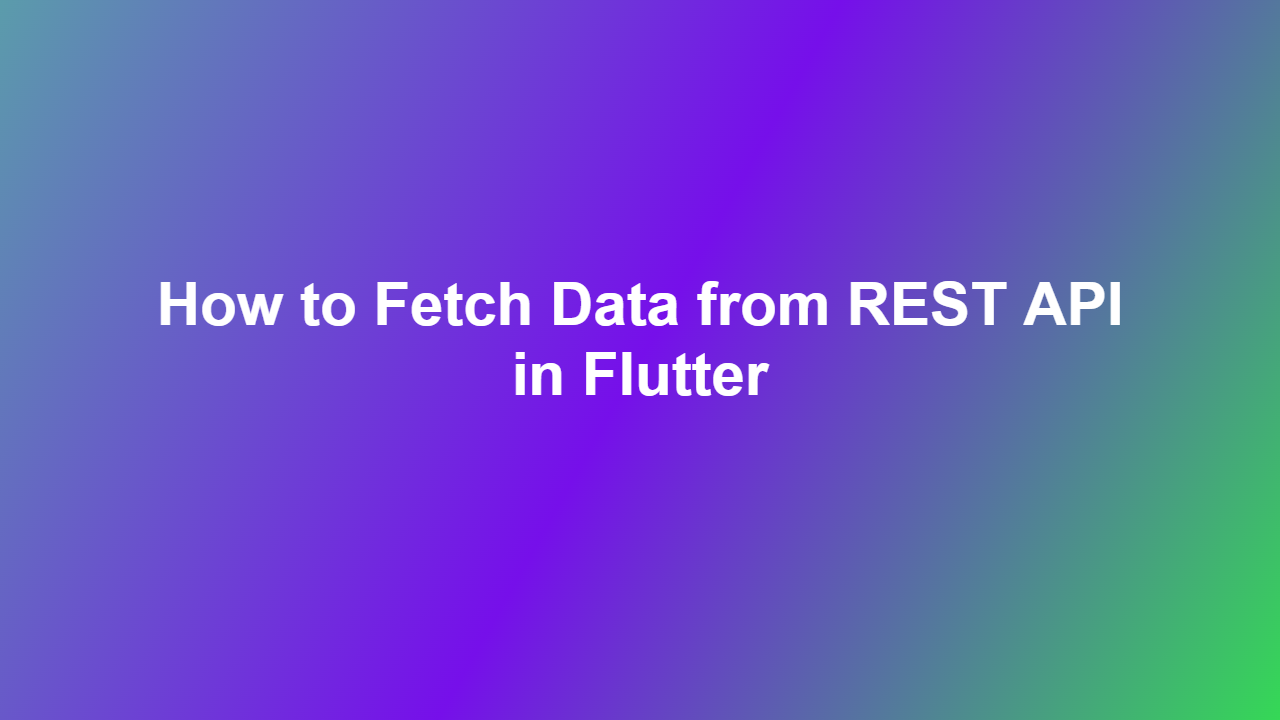How to Fetch Data from REST API in Flutter
=====================================================
Introduction
—————
In today’s mobile app development landscape, APIs (Application Programming Interfaces) play a crucial role in connecting multiple systems and exchanging data. Flutter, being a popular cross-platform development framework, makes it easy to interact with APIs and fetch data to power your app’s features. In this article, we’ll delve into the process of fetching data from REST APIs in Flutter, exploring the necessary steps, code examples, and considerations for a successful integration.
What is REST API and Why is it Important in Flutter
————————————————_
REST (Representational State of Resource) API is a popular architectural style for designing APIs. It’s based on the client-server model and uses standard HTTP methods to communicate with servers. REST APIs expose data and functionality as resources, which can be manipulated using verbs like GET, POST, PUT, and DELETE. In Flutter, REST APIs are essential for fetching data from backend servers, authenticating users, and integrating with third-party services.
Step 1: Choose an HTTP Client Library
————————————–
Flutter provides a built-in `http` package for making HTTP requests. However, you can also use other libraries like `http` or `chuck`. For this example, we’ll use the `http` package.
Install the `http` Package
Add the `http` package to your `pubspec.yaml` file:
“`yml
dependencies:
flutter:
sdk: flutter
http: ^0.13.3
“`
Then, run `flutter pub get` to install the package.
Import the `http` Package
In your Dart file, import the `http` package:
“`dart
import ‘package:http/http.dart’ as http;
“`
Step 2: Make a GET Request to Fetch Data
——————————————
To fetch data from a REST API, you’ll need to use the `http.get()` method. This method sends a GET request to the specified URL and returns a `Future` that resolves to a `Response` object containing the retrieved data.
Example Code: Fetching Data from a REST API
“`dart
import ‘package:http/http.dart’ as http;
void main() async {
// Replace with your API endpoint URL
final url = ‘https://jsonplaceholder.typicode.com/posts’;
try {
// Send a GET request to the API endpoint
final response = await http.get(Uri.parse(url));
// Check if the response was successful
if (response.statusCode == 200) {
// Parse the JSON data in the response body
final jsonData = jsonDecode(response.body);
// Process the data as needed
print(‘Fetched Data:’);
print(jsonData);
} else {
// Handle error cases, e.g., display an error message or show a loading indicator
print(‘Failed to fetch data: ${response.statusCode}’);
}
} catch (e) {
// Handle any network errors
print(‘Network error occurred: $e’);
}
}
“`
Step 3: Handle Error Cases
—————————
When working with APIs, you’ll encounter various error cases, such as network errors, 404 errors, or invalid responses. It’s essential to handle these cases to provide a smooth user experience.
Step 4: Implement Caching and Pagination
——————————————
To improve app performance and reduce data retrieval time, consider implementing caching mechanisms using libraries like `cachednetworkimage` or `shimmer`. Additionally, use pagination to fetch data in batches, reducing the payload size and improving user experience.
Conclusion
————–
Fetching data from REST APIs in Flutter is a crucial task for building robust and data-driven mobile applications. By following the steps outlined above, including choosing an HTTP client library, making GET requests, handling error cases, and implementing caching and pagination, you’ll be well-equipped to integrate REST APIs into your Flutter projects.
Frequently Asked Questions
—————————–
Q1: What HTTP Client Library should I use in Flutter?
A1: The `http` package is a popular choice for making HTTP requests in Flutter. It’s lightweight, easy to use, and well-maintained. However, you can also explore other libraries like `chuck` or `http_parser`.
Q2: How do I handle network errors in my Flutter app?
A2: To handle network errors, you can catch the `http.HttpException` exception, which is thrown when a network request fails. You can also use a try-catch block to catch any other unexpected errors.
Q3: What are the benefits of caching data in my Flutter app?
A3: Caching data in your Flutter app can improve performance by reducing the time it takes to fetch data from APIs. It can also reduce bandwidth usage and improve user experience by reducing the amount of time the app spends waiting for data to load.
Q4: How can I implement pagination in my Flutter app?
A4: To implement pagination, you can use the `http.get()` method to fetch a limited number of items per request. You can also use a library like `http.client` to implement pagination using a `ScrollController` to fetch more items as the user scrolls through a list.
Q5: How do I debug REST API issues in my Flutter app?
A5: To debug REST API issues, you can use the Dart Inspector to inspect the HTTP requests and responses. You can also use a library like `http_inspector` to inspect the HTTP requests and responses from within your Flutter app.
